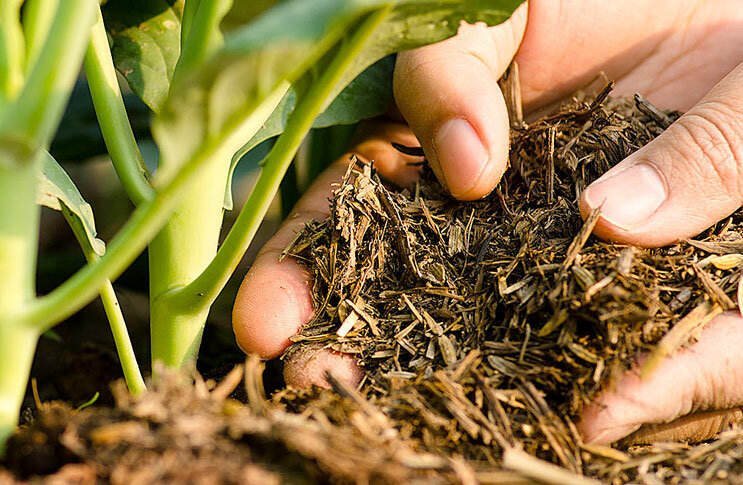Manure is a popular type of organic fertilizer that is widely used in rural areas. It is not always convenient for city gardeners and gardeners to use it. Often high-quality manure or humus is difficult to buy. In our article, we will talk about ways to replace popular fertilizer.

Liquid fertilizer
Liquid fertilizer from mowed grass is a low-cost, safe and effective way to grow horticultural crops. Herbal infusion contains a full range of necessary substances that are easily absorbed by them. To prepare liquid fertilizer, you will need:
- plastic ten-liter barrel - placed in an open sunny place;
- grass chopped by secateurs (celandine, nettle, cabbage leaves, mustard are suitable) - they fill the barrel with it, leaving 10-20 cm to the edges;
- pour a barrel of grass with warm water;
- regularly mixed throughout the depth for uniform fermentation;
In hot weather, the infusion is ready in one, at most two weeks. It becomes green and transparent without suspensions. To accelerate the fermentation process allows complex fertilizer (NRK complex) or nitrofoska. It is worth adding 30-40 g of nitrophoska to 50 l of water to the barrel with grass, and the process will end in 3-5 days. Useful composition at the rate of 0.5 l of solution per 10 l of water for spraying and watering the beds.
Bird droppings
The value of bird droppings in the content of calcium is 2.5%, nitrogenous substances - up to 2% and phosphatides (organic phosphorus). The fastest way to prepare:
- Fill a 10 liter bucket with 1/3 bird guano.
- Pour to the top with water and mix well.
- For top dressing, take 1 liter of the obtained concentrate under the root, dilute in 10 liters of water.
- The litter bucket is kept with the lid tightly closed so that nitrogen does not escape.
- In the fall, after harvesting, they dig a plot with fresh chicken droppings with litter (directly from the chicken coop) - during the winter, the organics decompose and enrich the soil with melt water before planting.
- Spread fresh manure around the site on melting snow or three weeks before planting;
Experienced gardeners believe that adding bird droppings as top dressing in the garden is enough once every three years. And it will work!
Nettle
Harmless, free, effective - all that a gardener needs is combining nettle fertilizer. Nettle is used as a liquid herbal fertilizer. All garden and berry crops, except onions and garlic, respond well to it. The recipe for cooking is simple: 1 kg of green chopped mass is poured with 10 liters of water. Leave to ferment for 10-15 days in an open container, stirring. When the liquid becomes dark green in color and transparent, the nettle solution is ready. For watering tomatoes, cucumbers and berry crops, the infusion is diluted 1: 5, for cabbage and leaf parsley - 1: 1. If spraying is necessary, the infusion is diluted 1:10 and filtered.
Sawdust
Getting humus from sawdust is a laborious method that takes a long time. But it is also used as a substitute for manure. First you need to prepare a compost heap. The basis is laid 20-30 cm of garden soil, the same layer of sawdust is poured. Then, 30 g of urea is diluted in 10 liters of water and watered with this solution of sawdust. Grass or plant tops, food waste are placed on top. The compost heap is covered with slaked lime, bone meal and ash. The heap “ripens” for 2-3 years. They shovel it every spring.
Siderata
Siderata - annual plants, rapidly gaining green mass, melliferous plants. They are planted for use as an organic fertilizer. Siderata include mustard, lupine, wheat, beans, calendula and other plants. Some of them are sown in gardens or greenhouses during the winter, for example, mustard. In early spring, it gains sufficient green mass, it is mowed and dug in the beds. Others, like fatselia or calendula, are planted in aisles - they scare away pests and attract melliferous insects. Siderats are used in compost heaps that are prepared for winter. They surpass animal fertilizers in their properties and as a substitute for manure - this is an excellent solution.
Compost
Compost in popularity and frequency of use is the second after manure. Depending on the components, compost is divided into: grassy, ??mixed, peat, sawdust-turf. To ripen it, a pit, or a box with removable sides, or an empty area in the garden about 2 by 3 meters in size. Straw is laid on the bottom of the pit or box. , sawdust, dry foliage. Then they put food waste, green tops of plants, the same green manure. A balance must be maintained between carbohydrates and nitrogen, that is, between the dry component and the green mass. Their ratio should be approximately the same.
Peat
Peat is an organic material decomposed and formed in swamps. At the place of formation, they distinguish: lowland, high and transitional.
When used in gardens peat improves the structure of the soil, increases its acidity, breathability.
It is preferable to use peat as a fertilizer in compost pits, mixing it with ash, green manure, and nitrogen fertilizers. Such compost is shoveled several times during the season. 20-30 kg of finished compost is used as fertilizer per 10 square meters. meters of garden land. We talked only about the part of organic mineral fertilizers that can be used as a substitute for manure. Combines their safety of use, efficiency and low cost. What to use is up to you.